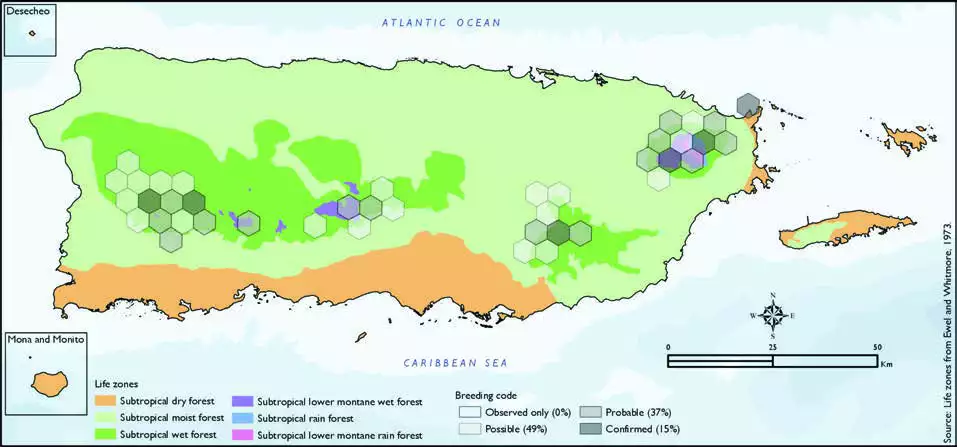Puerto Rican Tanager
Description
The Puerto Rican tanager (Nesospingus speculiferus) is a small passerine bird endemic to the archipelago of Puerto Rico. It is the only member of the genus Nesospingus and has historically been placed in the tanager family, but recent studies indicate it as either belonging in its own family Nesospingidae or as being a member of Phaenicophilidae. Its closest relatives are likely the spindalises (family Spindalidae, sometimes also considered a member of the Phaenicophilidae). The Puerto Rican tanager is known to locals as llorosa, which means 'cryer'.
Distribution & Habitat
The Puerto Rican Tanager is endemic to Puerto Rico and
is placed in its own family
(Nesospingidae), representing the
only endemic family known from
Puerto Rico. It is commonly found
in humid montane forests in the
Sierra de Luquillo, Toro Negro
State Forest, and the western mountain region surrounding
Maricao and Los Tres Picachos
State Forest (Miranda-Castro and
others 2000). In addition, it has
also been documented in the
Carite Forest (Raffaele 1989a),
other higher montane forests,
and a second-growth forest near
Cidra (Raffaele 1989a). In the early
1900s, it was restricted to montane
regions at a limited number of
locations such as Maricao, Toro
Negro and Carite State Forests,
El Yunque National Forest, and
near Cidra. Nevertheless, this
species has recently expanded its
distribution range to other suitable
habitats in municipalities such as
Comerío, Aibonito, Baranquitas,
Adjuntas, and the haystack hills of
Ciales (Oberle 2018). The species
occurs primarily in undisturbed
mountain forests but can also be
seen in disturbed second-growth forests (Raffaele and others
1998) and is restricted mainly to
the subtropical moist, wet, and
montane forest life zones (Biaggi
1997, Raffaele 1989a). The atlas
fieldwork yielded a total of 82
records within 41 hexagons or 8.5
percent of the 479 total hexagons
(see map). Of the 41 hexagons
where this species was found,
breeding met the atlas definition of
confirmed in 15 percent (6) of the
hexagons, probable in 37 percent
(15), and possible in 49 percent
(20) (see map). Puerto Rican Tanager distribution. The map shows the highest breeding code by hexagon and overlaying the ecological life zones in
Puerto Rico. Note: percentages may not total 100 due to rounding.

Breeding Habits
Previously published reports
indicate that the Puerto Rican
Tanager breeding extends from
January through August (Raffaele
1998), but active nests have also
been seen in September (Pérez- 259Puerto Rican Tanager/LlorosaRivera 1993). The nests are cup-shaped, built from 2 to 10 m above
the ground (Raffaele 1998), and
are usually made of vines, roots
of epiphytes, and fibers of sierra
palm leaves (Pérez-Rivera 1993). Formation of pairs starts in May,
and nesting is usually completed
by August (Recher and Recher
1966). The nesting territories
are usually defended from late
December to the end of July
(Pérez-Rivera 1993). Atlas results indicate that the breeding season
extends from November through
July (see chart). The breeding
pattern peaks during May at the
onset of the rainy season, and
the breeding activity mostly takes
place in humid montane areas
within the subtropical wet forest
life zone. However, an unusual observation at the eastern coast of
the island suggests that this species
also breeds in the subtropical dry
forest life zone during December.
Results show that this species
breeds mostly at high elevations
in the subtropical wet and lower
montane wet forest life zones (71
percent of the hexagons), as well
as other mountain regions within
the subtropical moist forest life
zone (24 percent of the hexagons)
(see table and map). It also breeds
in the subtropical rain and lower
montane rain forest life zones
located in the Sierra de Luquillo
(2 percent of the hexagons), and
in a coastal locality at the eastern
region within the subtropical dry
forest life zone (2 percent of the
hexagons) (see table and map).
Conservation
The population size for the Puerto
Rican Tanager has not been
quantified or assessed, but it is
described as fairly common (Stotz
and others 1996). This species is
currently listed as a species of least
concern by the IUCN (BirdLife
International 2016). Locally, this
species is not listed in any of the
threatened categories of PRDNER
and USFWS. In Puerto Rico,
the Puerto Rican Tanager has a
protected habitat in land of about
21 percent (205 km2) of the total area covered by the hexagons
where evidence of breeding was
found for this species (980 km2).
Related Species
Family:
tanager